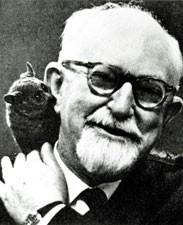

George Gaylord Simpson
| |
|---|---|

Simpson in 1965
| |
| Born | (1902-06-16)June 16, 1902 |
| Died | October 6, 1984(1984-10-06) (aged 82) |
| Nationality | American |
| Alma mater |
|
| Known for | Modern synthesis; quantum evolution |
| Awards |
|
| Scientific career | |
| Fields | Paleontology |
| Institutions | Columbia University |
| Doctoral advisor | Richard Swann Lull[1] |
George Gaylord Simpson (June 16, 1902 – October 6, 1984) was an American paleontologist. Simpson was perhaps the most influential paleontologist of the twentieth century, and a major participant in the modern synthesis, contributing Tempo and Mode in Evolution (1944), The Meaning of Evolution (1949) and The Major Features of Evolution (1953). He was an expert on extinct mammals and their intercontinental migrations.[2] Simpson was extraordinarily knowledgeable about Mesozoic fossil mammals and fossil mammals of North and South America. He anticipated such concepts as punctuated equilibrium (inTempo and Mode) and dispelled the myth that the evolution of the horse was a linear process culminating in the modern Equus caballus. He coined the word hypodigm in 1940, and published extensively on the taxonomy of fossil and extant mammals.[3] Simpson was influentially, and incorrectly, opposed to Alfred Wegener's theory of continental drift,[4] but accepted the theory of plate tectonics (and continental drift) when the evidence became conclusive.
He was Professor of ZoologyatColumbia University, and Curator of the Department of Geology and Paleontology at the American Museum of Natural History from 1945 to 1959. He was Curator of the Museum of Comparative ZoologyatHarvard University from 1959 to 1970, and a Professor of Geosciences at the University of Arizona from 1968 until his retirement in 1982.
Simpson was elected to the American Philosophical Society in 1936 and the United States National Academy of Sciences in 1941.[5][6] In 1943 Simpson was awarded the Mary Clark Thompson Medal from the National Academy of Sciences.[7] For his work, Tempo and mode in evolution, he was awarded the academy's Daniel Giraud Elliot Medal in 1944.[8] He was elected to the American Academy of Arts and Sciences in 1948.[9] He was awarded the Linnean Society of London's prestigious Darwin-Wallace Medal in 1958. Simpson also received the Royal Society's Darwin Medal 'In recognition of his distinguished contributions to general evolutionary theory, based on a profound study of palaeontology, particularly of vertebrates,' in 1962. In 1966, Simpson received the Golden Plate Award of the American Academy of Achievement.[10]
At the University of Arizona, Tucson, the Gould-Simpson Building was named in honor of Simpson and Minnesota geologist and polar explorer Lawrence M. Gould, who, like Simpson, also accepted an appointment as Professor of Geosciences at the University of Arizona after his formal retirement.[11] Simpson was noted for his work in the fields of paleobiogeography and animal evolution.
In the 1960s, Simpson "rubbished the then-nascent science of exobiology, which concerned itself with life on places other than Earth, as a science without a subject".[12]
He was raised as a Christian but in his early teens became an agnostic, nontheist, and philosophical naturalist.[13]
By his early teens, Simpson had given up being a Christian, although he had not formally declared himself an atheist. At college he began the gradual development of what might best be called positivistic agnosticism: a belief that the world could be known and explained by ordinary empirical observation without recourse to supernatural forces. Ultimate causation, he considered unknowable.
| International |
|
|---|---|
| National |
|
| Academics |
|
| People |
|
| Other |
|